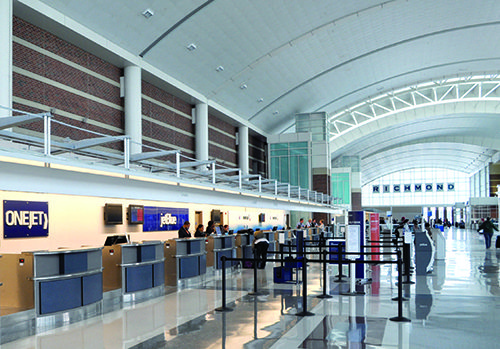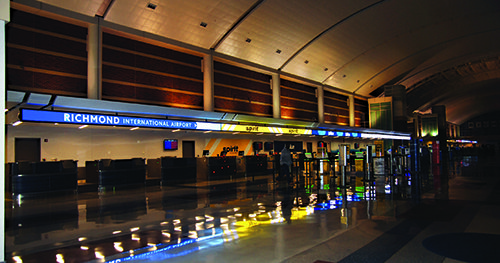When Richmond International Airport (RIC) built its new terminal in 2007, the original budget included funds for an array of state-of-the-art digital displays in the passenger check-in area. However, escalating construction costs and subsequent value engineering resulted in a much different outcome.
When Richmond International Airport (RIC) built its new terminal in 2007, the original budget included funds for an array of state-of-the-art digital displays in the passenger check-in area. However, escalating construction costs and subsequent value engineering resulted in a much different outcome.

For the past dozen years, the thriving Virginia airport used passive text on metal signboards to indicate airline positions and queues for passengers in various seating classes. That all changed in January, when RIC unveiled its new cantilevered canopy above the ticketing counters, complete with a border of two 4-millimeter LED ribbon video displays, each stretching 150 feet long.
Russ Peaden, director of Airport Real Estate and Facilities, was not a fan of the rudimentary light boxes with vinyl letters that the new systems replaced. “Block lettering showed, ‘First Class’ here, or ‘Drop Bag’ there,” Peaden recalls. “The plan had been to have better digital imaging over the ticket counter to give it a more professional and modern look. All along, it was something that we wanted to do; it was just a matter of timing and funding.”
|
Project: New Check-in Canopy & Counter Signage Location: Richmond (VA) Int’l Airport Cost: $990,000 Project Timeline: 2017-Jan. 2019 Architect: Gresham Smith
General Contractor: RMT Construction Display & Content Provider: Daktronics Sign Subcontractor: Casbro Digital Signage Electrical Subcontractor: Local Electric Company Inc. Special Systems/Technology Consultant: Arora Engineers Inc. Electrical Engineer: Engineers Plus, P.C. |
Naturally, he is pleased that RIC recently achieved, and even improved upon, the signage included in its initial terminal plans. “It was fortunate that we were able to pull it together as we have,” he says.
Peaden credits Jon E. Mathiasen, the airport’s chief executive officer, for initiating the $990,000 project two years ago.
Standout Design
The airport hired Gresham Smith for architectural and engineering design services to replace the canopy above its ticketing/check-in counters, and then rolled the signage update into the larger canopy project. The firm has worked with RIC on many projects since 1992.
“We replaced the canopy with a similar design for continuity and wayfinding, but a little different, updated aesthetic,” says Eric Sweet, a senior interior designer with the company. “The wash of new LED lighting freshened up the entire area.”
While Gresham Smith led the design efforts, Arora Engineers provided technical and systems consulting.

“Arora helped us out with lighting the stack and understanding, specifically, how fine the pixel pitch needed to be with regard to viewing distance, size and cost,” Sweet explains.
Daktronics was selected via a public bid process to manufacture the $500,000 digital sign.
“Instead of having one small display over each counter position, they wanted one large, continuous display to use for wayfinding and to provide an architectural element,” remarks Daktronics Regional Sales Manager Kevin Palmeter.
Electrical and data support was provided by the general contractor (RMT), electrical subcontractor (Local Electric) and signage subcontractor (Casbro). Ancillary projects included installing new lights and re-wiring existing circuits.
The Softer Side
Beyond providing hardware, Daktronics also helped on the software side with content development.
Because the new digital display spans the entire ticketing area, it can be used to provide travelers with a little entertainment while they wait, notes Palmeter. While RIC has yet to leverage such additional elements, it may elect to offer news, flight information or other types of content on the new display in the future.
“There is additional usable space beyond just displaying ‘first class’ here, ‘business class’ here, and ‘bag drop’ there,” Palmeter explains. “The airport can change those messages out. They could display seasonal or holiday messages.”

Palmeter credits his Daktronics colleague, RIC Project Manager Sarah Opitz, for leading the airport through its first round of content creation using Venus Control Suite software.
“Most of the content was just utilizing the airline logos with their colors,” Opitz says, noting that the design ranged from passenger prompts for specific carriers to a general “Welcome to Richmond International Airport” message above vacant counter spaces.
All seven of RIC’s major airlines are currently using Daktronics-designed broadcast images, and the company remains on call to assist them in developing new content in the future.
Intrinsic Value
With the installation complete, Peaden is pleased with the new display’s messaging, information and quality.
“It is a good, long-lasting product that will wear well and has a lot of utility,” he comments. “The way Gresham Smith specified the components and system, it’s not going to be obsolete tomorrow. The ability exists to grow into it, and I think it’s a win/win.”
While Peaden doesn’t envision running paid advertising on the new display, he says it still provides value for the airport.
“The return on investment is the finishing touch of an overall enhanced image at the ticket counter,” he explains. “The display has a long-term payback, in terms of the ability for it to grow as a dynamic sign. There are a lot of capabilities there that we’ve yet to really appreciate, but we are already realizing benefits. It has been a quick partial payback on a long-term investment.”
Before:

After:



 facts&figures
facts&figures

